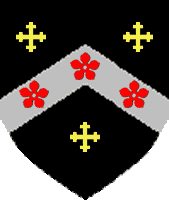

Description one:
This comes from the Book of Arms at College of Arms collected by Robert Glover, Somerset Herald and made c.1566 No. 405. "He beareth Sable on a chevron Argent, three cinquefoils Gules, between three cross crosslets Or, as the cost of Mottram of Mottram which after took the name of Mottershead from the owning of an ancient parcell of lands called Mottersheved in the lordship of Mottram" Enrolled, College of Arms dated April 1692 and signed by, - "Sr.Jo.Dugdale, Norroy, and Gregory King, Lancaster Herald, Register of the College of Arms.
Description two:
"Sable, on a chevron argent, between three crosses crosslet or, as many quatrefoils gules" (source: Burke, Encyclopaedia of Heraldry, 1944).
This comes from the Book of Arms at College of Arms collected by Robert Glover, Somerset Herald and made c.1566 No. 405. "He beareth Sable on a chevron Argent, three cinquefoils Gules, between three cross crosslets Or, as the cost of Mottram of Mottram which after took the name of Mottershead from the owning of an ancient parcell of lands called Mottersheved in the lordship of Mottram" Enrolled, College of Arms dated April 1692 and signed by, - "Sr.Jo.Dugdale, Norroy, and Gregory King, Lancaster Herald, Register of the College of Arms.
Description two:
"Sable, on a chevron argent, between three crosses crosslet or, as many quatrefoils gules" (source: Burke, Encyclopaedia of Heraldry, 1944).



Distinct, however, from the crosslet is the cross crosslet, or, as it is sometimes, though rarely, termed a cross crossed (Fr. croix croisée). By rights, however, a cross crossed is equivalent to a cross crosslet fixed, that is, the arms extend to the extremities of the escutcheon.


(Fr. quartefeuille): a charge the design of which may have been derived from some four-leaved flower, but more probably produced in the course of the ordinary workman's craft. It should be drawn pierced, unless described as blind.
(Note - some may be familiar with the "trefoil" plant - e.g. "bird's foot trefoil". It may help understanding "quatrefoil" and "cinquefoil" if one thinks of a "trefoil" as being a "three-leaved quatrefoil or quatrefoil").



Black background, with a silver chevron between three gold crossed crosses, and as many (3) red cinquefoils (or quatrefoils).